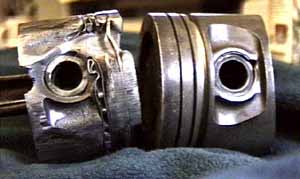
Fuel pumps, pressure
regulators, pinch valves and rising rate regulators.
Fuel pumps
Stock fuel pumps seem to be adequate for engines making horsepower in the 270-290 hp range; over that is the deadly risk of Russian roulette with your pistons! I had a 2.5 turbo we were testing in my 86 Turbo Z when it ran out of fuel at 21 psi of boost. Piston number 3 looked like someone had taken a blowtorch to it!

(This isn't the piston that melted but they all look the same)
Its very important to keep an eye on your air/fuel gauge or EGT to make sure you're not leaning out.
Want a cheap way to keep your fuel pump happy? Change your filter every year; cheap insurance for your engine and your fuel pump.
Once you start to get in the big hp category there's two options you have for your fuel system. One is to install a larger fuel pump (preferred.) The other is to install a second pump. The problem with running two pumps is if one fails while making a pass, more often than not you will burn up a piston; any money you saved by not buying one large pump will have been wasted.
Myself I use an Accel fuel pump (ACC-74702) in the tank of the Daytona gas tank and 5/16 fuel line (The Reliant has the pump mounted externally with 3/8 line) run to the front of the car to insure that there is plenty of volume to keep my motor happy. Other fuel pumps of course will work, and you will have to do some modification with any pump you use, that's one of the joys of hotrodding! Here is a link to a site that does group purchases of fuel pumps for very reasonable prices.
http://autoperformanceengineering.com/
(I haven't purchased through this site myself but other members of SDAC have.)
Fuel pressure regulators
Pressure regulators control the amount of fuel pressure that is applied to the injectors. The stock regulators work on a 1 to 1 ratio.
A. At idle, (15 inches of vacuum) you have
45 psi of fuel pressure.
B. At 0 psi, (neither vacuum or boost) you
have 55 psi of fuel pressure.
C. At 10 psi of boost, you have 65 psi of
fuel pressure.
D. At 20 psi of boost, you have 75 psi of
fuel pressure.
This is called a pressure referenced compensating regulator. For every pound of boost, your fuel pressure will also rise 1 psi. Now they also make adjustable pressure regulators that let you adjust the range of your fuel pressure up or down; the only problem of course is that if you turn the pressure up 10 psi because your lean at WOT, your fuel pressure at idle goes up too! This may cause you to run rich at idle if your computer cannot compensate.
Sometimes tweaking of the pressure is need due to fine tuning or in the case of larger injectors in conjunction with a rising rate regulator- There are some other car manufactures regulators that will work with our application (I'm told a regulator for a Grand Nation Buick with work as well as some tune port injected Firebird and Camaros) Holley, Accel and Mr. Gasket all make adjustable units for these applications.
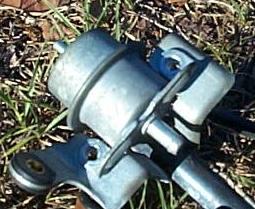
Also don't be afraid to poke around the junkyards if you get a chance- One of my readers found that a 87 Volvo 2.3 turbo has a regulator that's identical to our TII motors but set 15 psi lower- great if you want to run oversize injectors! The Volvo non-turbo regulator looks the same but is missing the vacuum nipple needed for turbo use.
James
Richardson of Canada offers to convert
your stock regulator over to an adjustable unit for a reasonable price, drop him
a line- I have one of his units on Relentless and it's pretty slick!
Rising rate regulators
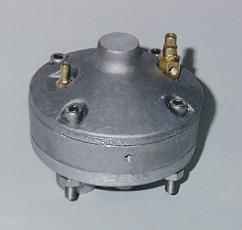
A Cartech 20002 unit
There are also aftermarket regulators called rising rate regulators that work on a 1.5 to 1 ratio or even higher. For every pound of boost, your fuel pressure would rise 1.5 psi with the above ratio. Of course this is only good up to the maximum safety limit of the typical injector which is 70 psi at the pintle.
For example:
90 psi of fuel MINUS 20 pounds of boost EQUALS 70 psi of pressure at tip of injector.
(Remember you must take into account boost pressure which is applying pressure in the opposite direction of your fuel pressure) On the Reliant I'm using a combination of extra injectors and a R.R.R. setup. The car is running 52 p.p.h. injectors but because the computer isn't calibrated for them (stock is 33 p.p.h.) so the fuel pressure has to be turned way down to keep it from running filthy rich. So I have 20-25 psi at idle which is fine but at 30 psi of boost I would have only 55 psi at the injector (less at the tip, remember the fuel pressure has to work against the boost pressure so that at 30 psi of boost only 25 psi of fuel pressure is getting released at the tip of the injectors pintle, YIKES!)
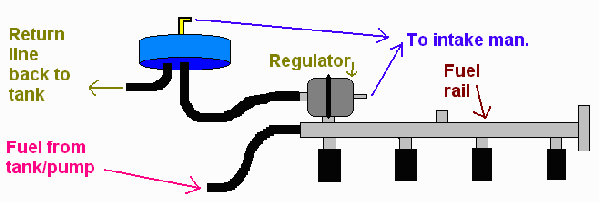
So
how can I take advantage of the larger injectors you say? Ahh that's where the
R.R.R. comes in- At some point in the engines boost curve it starts to take over
from the regular 1 to 1 regulator so that by the time I'm at 30 psi I have 100
psi of fuel pressure! Which works out to exactly 70 psi at the injectors pintle.
Pinch Valves
Pinch valves are devices that block the flow of fuel returning to the gas tank. This causes fuel pressure to rise to the fuel pumps highest internally set pressure regardless of what your pressure regulator is set at. On a stock application this is 95 psi which is really over the border for your fuel injectors even at 20 psi of boost. On my Accel fuel pump it would send my fuel pressure off scale! Not good. The old setup had a second fuel regulator in the line so that when the pinch valve hit it would not let the fuel pressure go over a certain point.
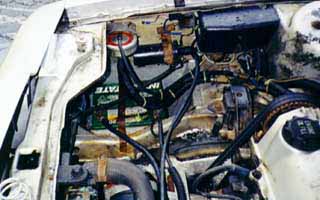
This is a picture of a pinch valve installed in the K-car, its the round silver disk with a red stripe directly over the battery.
The other down side of a pinch valve is that if they are hooked directly to a engine vacuum/boost line is that they tend to come on at a fairly low setting. (5 psi) On my car I used an electric pressure switch and solenoid to control when the pinch valve was turned on and off, or you can bleed the reference line going to the valve which would have the same effect.
You can turn a pinch valve into a R.R.R. by bleeding the boost reference line going to the top of the unit, this is what I have done in Relentless and is pretty much all that a R.R.R. does too.
They are also somewhat pricey
($300) last time I checked; I was using one because it was
given to me! Can't beat that with a stick.
Gus Mahon has a great page
on fuel pressure regulators and fuel system mods! Head on over to his page and check
it out!